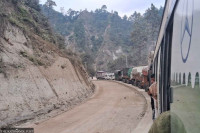Opinion
Up in the hills
Salakpur is not only a top producer of cardamom but also a potential tourism spot
Sony KC
The experience of losing cardamom crops to disease is still a poignant memory for farmers in Ilam district. Since September 2014, I have made four long trips to various villages of Ilam, researching cardamom cultivation and the livelihoods of farmers. Growing this plant, whose seeds are used as a spice, used to be the main source of income for a majority of households in Ilam. In the beginning of my fieldwork, I only heard horrifying stories of disease infestation in cardamom farms and a decline in production. This had an adverse impact on the livelihoods of cardamom growers. Some villages that once produced a large quantity of cardamom have now become stopped growing the crop. People in these villages have adopted alternative livelihood options by abandoning cardamom for tea and vegetables. Moreover, lost cardamom species such as Ramsai, Golchai, Chibeysai and Bharlang have been replaced by the prominent species Salakpurey today.
Salakpurey cardamom
Salakpurey cardamom comes from Salakpur village in Jirmale Village Development Committee (VDC) in Ilam. The actual story of cardamom farming in Salakpur is unknown. But some people say that a few farmers who visited Mirik, Darjeeling many years ago brought it to Ilam. Little did the farmers know that this crop would change the livelihood status of the people in Salakpur. In the past one decade, Salakpur has gained immense popularity and has produced massive quantities of cardamom for export. Farmers from Kathmandu, Gorkha, Dhading, Dolakha and Dang have bought cardamom saplings from Salakpur. Also, every agriculturist and cardamom expert does not fail to mention Salakpur as a top producer of cardamom and mandarin orange. Though little known across Nepal, this village possesses high tourism potential with majestic views of the Mechi River, beautiful orange groves, high hills which offer views of the sunrise and sunset, stupas and trekking trails.
I visited Salakpur last August, two days before the cardamom harvesting season. For the first two days, I wandered around building rapport with the community and observing their work. The farmers seemed busy preparing for the harvest. While some were honing their special knives to pick cardamom, others were cleaning the cardamom dryer to dry the harvested cardamom. A few households with large cardamom farms had already informed other households about their harvesting dates. This is done to call labourers from other households for ‘parma’, a system where they work on each other’s farms in turn. Such workers are provided food but no cash. Some households also hire workers by paying them a daily wage of Rs 300-350 depending on the type of work.
A new crop
I understood that Salakpur’s farming practices and crops were different years ago. Before cardamom, this village used to be known for growing and exporting ginger and orange. In addition, households also produced rice mostly for subsistence consumption. The fortunes of this village changed when disease infestation in ginger became uncontrollable and inevitable. Despite continuing efforts to save ginger, farmers quickly adopted cardamom farming as an alternative. Cardamom farming not only came as an alternative to disease but also as an alternative to other crops such as rice. “We used to grow rice, but when I saw my neighbours making more money with less effort by producing cardamom, I planted cardamom instead of rice on my fields,” said a woman farmer.
According to farmers, rice requires lots of irrigation water compared to cardamom. Also, the return from the food grain is very little compared to the spice. One farmer had this to say, “What could I do producing rice? It would only be enough to feed the family. I can produce cardamom, and not only buy rice but also oil, salt, clothes and meet other household expenses with the money.”
Today, Salakpur is one of the leading villages in Ilam for cardamom export. Additionally, this village still produces a high volume of oranges for shipment across the border. Every December, the bright orange festival welcomes more than a thousand tourists from India. However, there is little recognition of this majestic place as a tourist destination.
Overall, the farmers seem to be satisfied with their engagement in cardamom farming. This is due to the high returns. However, there are also fears of losing cardamom and orange to disease. “Till now, nothing has happened to our cardamom farms, but we fear they might meet the fate of ginger. We have already witnessed a decline in orange production this year due to disease,” said a farmer. Another farmer said, “The good thing about our village is that we help each other. This is why most of us have cardamom farms today. Also, we always think about alternatives if we sense that our crops might fail. We cannot wait for the government or institutions to reach us. If we do so, we will end up hungry.”
A model village
Three years ago, a cooperative for crops such as cardamom and orange was established to support farmers. This cooperative aims to strengthen their production. “We have just started, and we have a long way to go. We are happy that we have, at least, started one,” said the president of the cooperative. Presently, it encourages farmers to become members and deposit their savings to obtain credit benefits. In the long run, the aim is to find ways to the combat diseases in the crops by inviting technical experts and seek ways to collaborate with institutions that can help strengthen and promote their products. Farmers have already joined hands to explore the possibilities of combating disease in oranges.
At this point, Salakpur seems to be an independent model village because of its strong social network among farmers. Changing crops due to failure is difficult, but adopting alternative measures quickly is a better coping strategy. The farmers’ decision to shift to Salakpurey cardamom when ginger began to fail reflects their perseverance to secure their livelihoods. Moreover, there was support within the community. This is also why the ‘queen of spices’ still exists as a high-value, export-led crop of Nepal. At the same time, policymakers should also find ways to promote tourism in Salakpur.
KC is a PhD candidate of feminisation of agriculture transition and rural employment, Kathmandu University




 16.57°C Kathmandu
16.57°C Kathmandu












